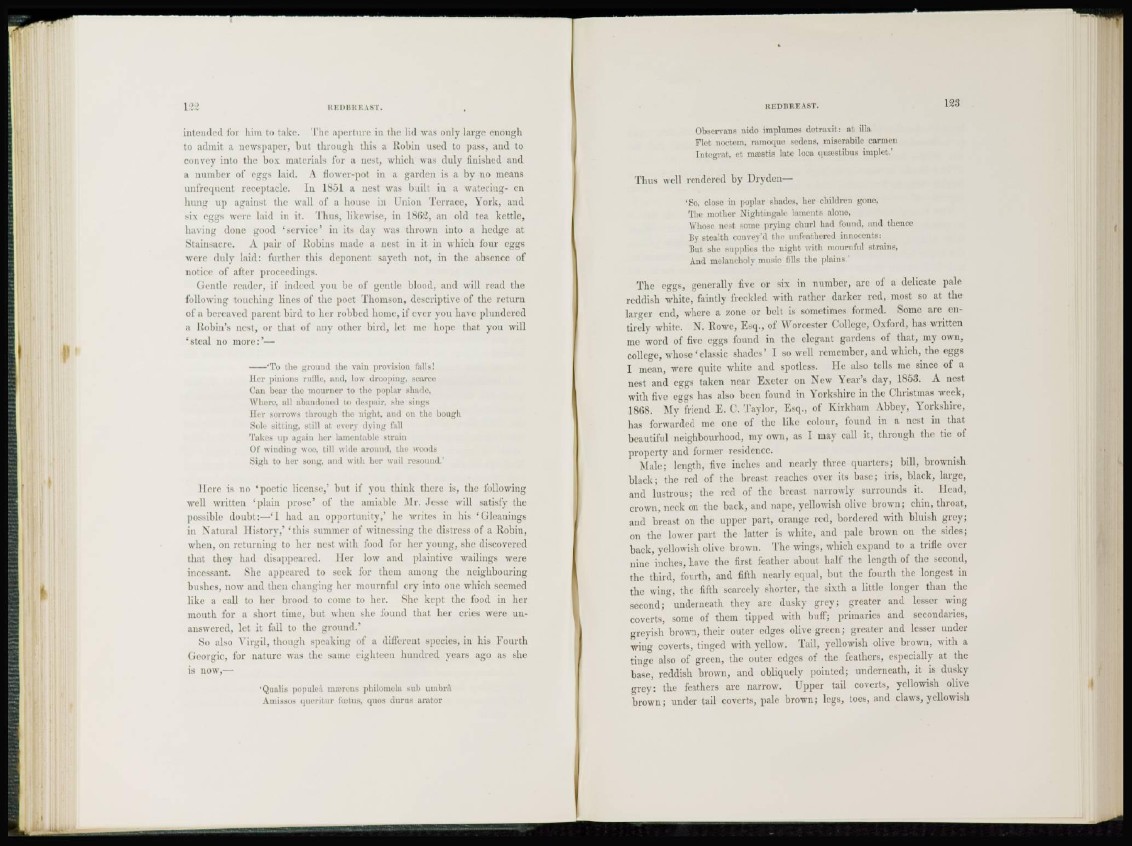
intended for him to take. The aperture in the lid was only large enough
to admit a newspaper, but through this a Robin used to pass, and to
convey into the box materials for a nest, which was duly finished and
a number of eggs laid. A flower-pot. in a garden is a by no means
unfrequent receptacle. In 1851 a nest was built in a watering- cn
hung up against the wall of a house iu Union Terrace, York, and
si\ eggs were hud in it. Thus, likewise, in 186&, an old tea kettle,
Inn ing done good 'service' in it-- da) was thrown into a hedge at
Stainsacre. A pair of Robins made a nest in it in which four eggs
were duly laid: further this deponent sayeth not, in the absence of
notice of after proceedings.
Gentle reader, if indeed you be of gentle blood, and will read the
following touching lines of the poet Thomson, descriptive of the return
of a bereaved parent bird to her robbed home, if ever you have plundered
a Robin's nest, or that of any other bird, let me hope that you will
' steal no more:'—
'To the ground the vain provision falls!
Her pinions ruffle, and, low drooping, scarce
Can bear the mourner to the poplar shade,
Where, all abandoned HI despair, sin.* sings
llw sorrows through the night, and mi the bough
Sele sitting, still at every dying fall
Takes up again her lamentable strain
Of winding woe, lilt wide around, the woods
Sigh to her song, and with her wait resound.'
Here is no 'poetic license,' but if you think there is, the following
well written ' plain prose* of the amiable -Mr. .I esse will satisfy the
possible doubt:—'1 had an opportunity,' he writes in his 'Gleanings
in Natural History,' 'this summer of witnessing the distress of a Robin,
when, on returning to her nest with food for her young, she discovered
that they had disappeared. Her low and plaintive wailings were
incessant. She appeared to seek for them among the neighbouring
bushes, now and then changing her mournful cry into one which seemed
like a call to her brood to come to her. She kept the food in her
mouth for a short time, but when she found that her cries were unanswered,
let it fall to the ground.'
So also Virgil, though speaking of a different species, in his Fourth
Georgic, for nature was the same eighteen hundred years ago as she
is now,—
•Qualis populea matrons philomela sub umbra
Amissos queritur tiutus, IJUOS dnrus arator
Obwervans nido implnmes detraxit: at ilia
Flct noctcm, rumoqiie sedens, miserabile carmen
[ntegrat, et maastis late looa qneeatibus implet.'
Thus well rendered by Dryden—
'So, close in poplar shades, her children gone.
The mother Nightuigute laments alone,
Whose iii'sl some prying churl had found, anil thence
By stealth convey'd the unfeathered innocents:
But the supplies the night with mournful strain?,
And melancholy nuisii- fills the plains '
The eggs, generally five or six in number, arc of a delicate pale
reddish white, faintly freckled with rather darker red, most so at the
larger end, where a zone or belt is sometimes formed. Some are entirely
white. N. Rowe, Esq., of Worcester College, Oxford, has written
me word of five eggs found in the elegant gardens of that, my own,
college, whose 'classic shades' 1 so well remember, and which, the eggs
I mean, were quite white and spotless. He also tells me since of a
nest and eggs taken near Exeter on New Year's day, 1853. A nest
with five eggs has also been found in Yorkshire in the Christmas week,
18(i8. My friend E. C. Taylor, Esq., of Kirkham Abbey, Yorkshire,
has forwarded me one of the like colour, found in a nest in that
beautiful neighbourhood, my own, as I may call it, through the tie of
property and former residence.
Male; length, five inches and nearly three quarters; bill, brownish
black; the red of the breast reaches over its base; iris, black, large,
and lustrous; the red of the breast narrowly surrounds it. Head,
crown, neck on the back, and nape, yeUowish olive brown; chin, throat,
and breast on the upper part, orange red, bordered with bluish grey;
on the lower part the latter is white, and pale brown on the sides;
back, yellowish olive brown. The wings, which expand to a trifle over
nine inches, have the first feather about half the length of the second,
the third, fourth, and fifth nearly equal, hut the fourth the longest in
the wing, the fifth scarcely shorter, the s i \ t h a little longer than the
second; underneath they arc dusky grey; greater and lesser wing
coverts, some of them tipped with buff; primaries and secondaries,
greyish brown, their outer edges olive green; greater and lesser under
wing coverts, tinged with yellow. Tail, yellowish olive brown, with a
tinge also of green, the outer edges of the feathers, especially at the
base, reddish brown, and obliquely pointed; underneath, it is dusky
grev: the feathers are narrow. Upper tail coverts, yellowish olive
brown; under tail coverts, pale brown; legs, toes, and claws, yellowish